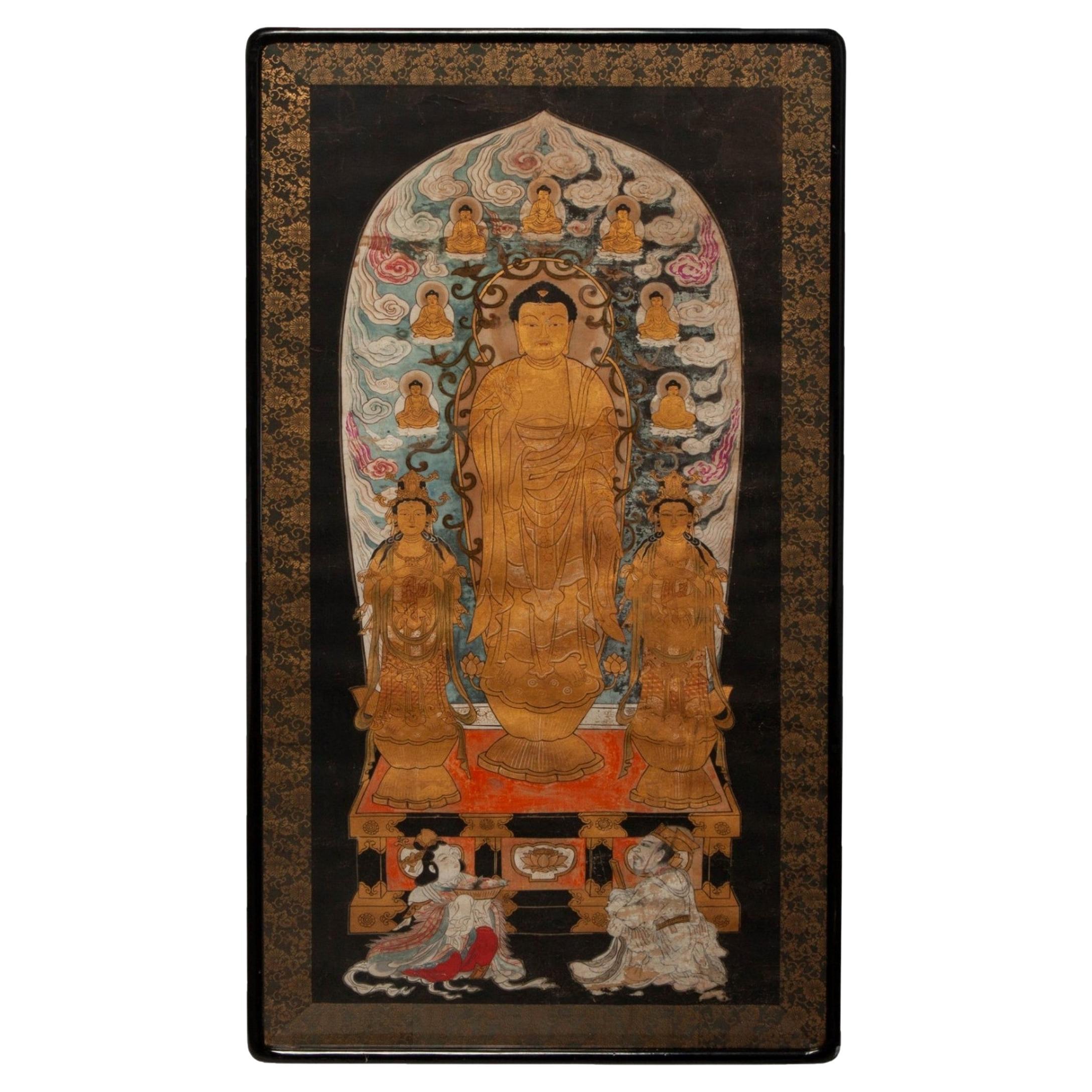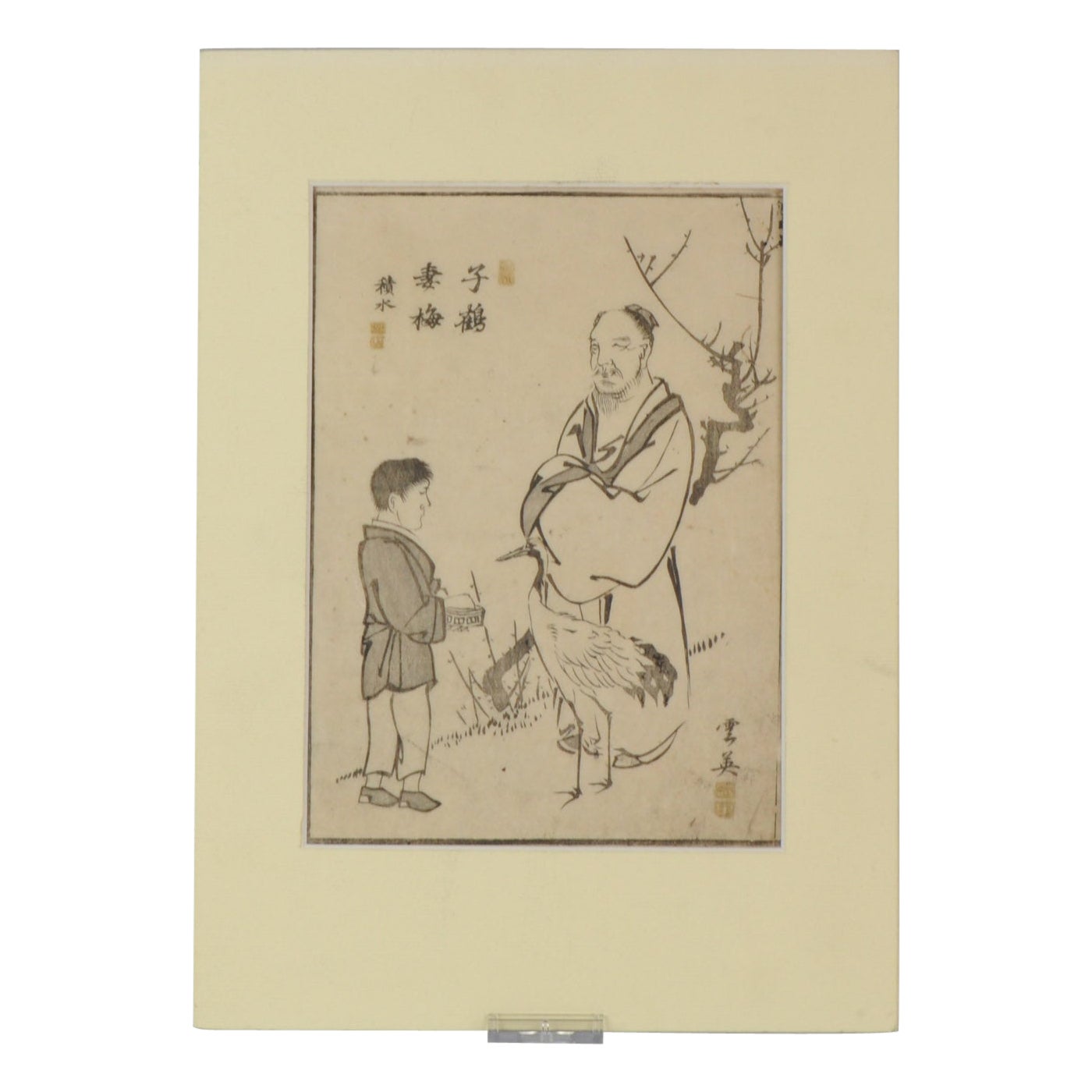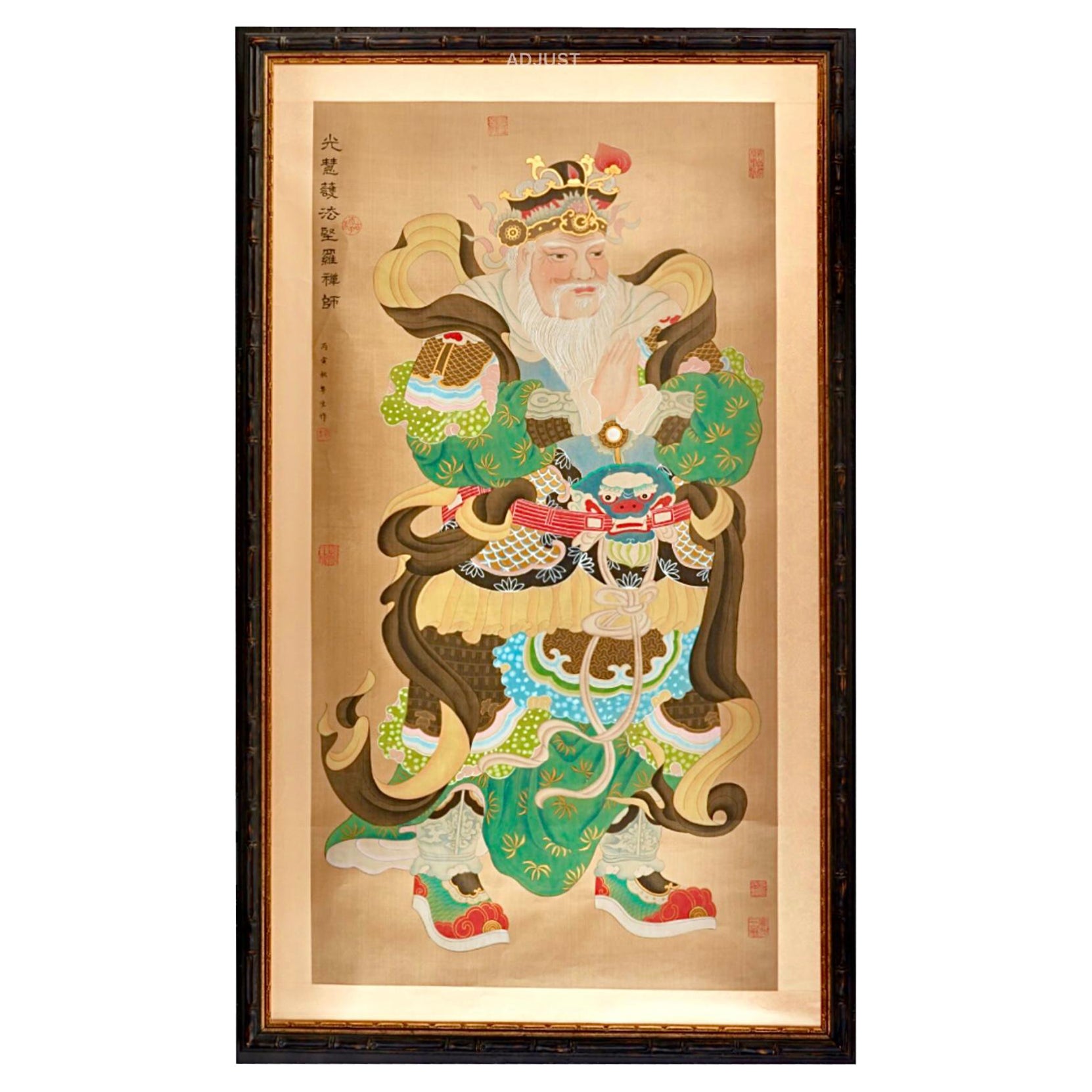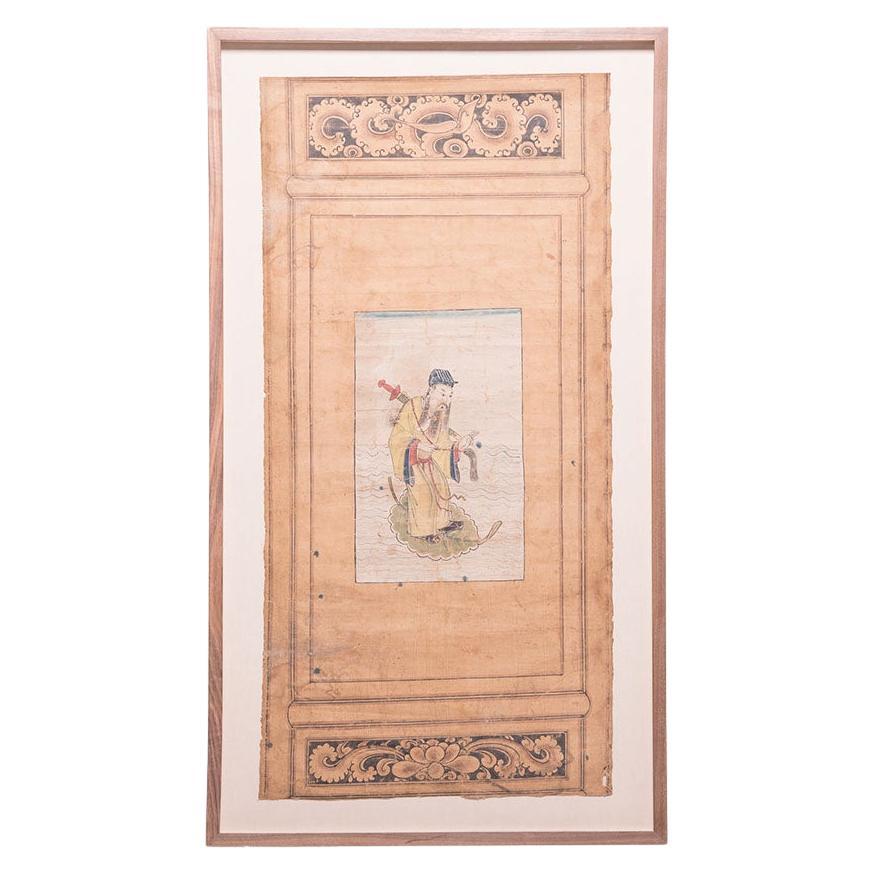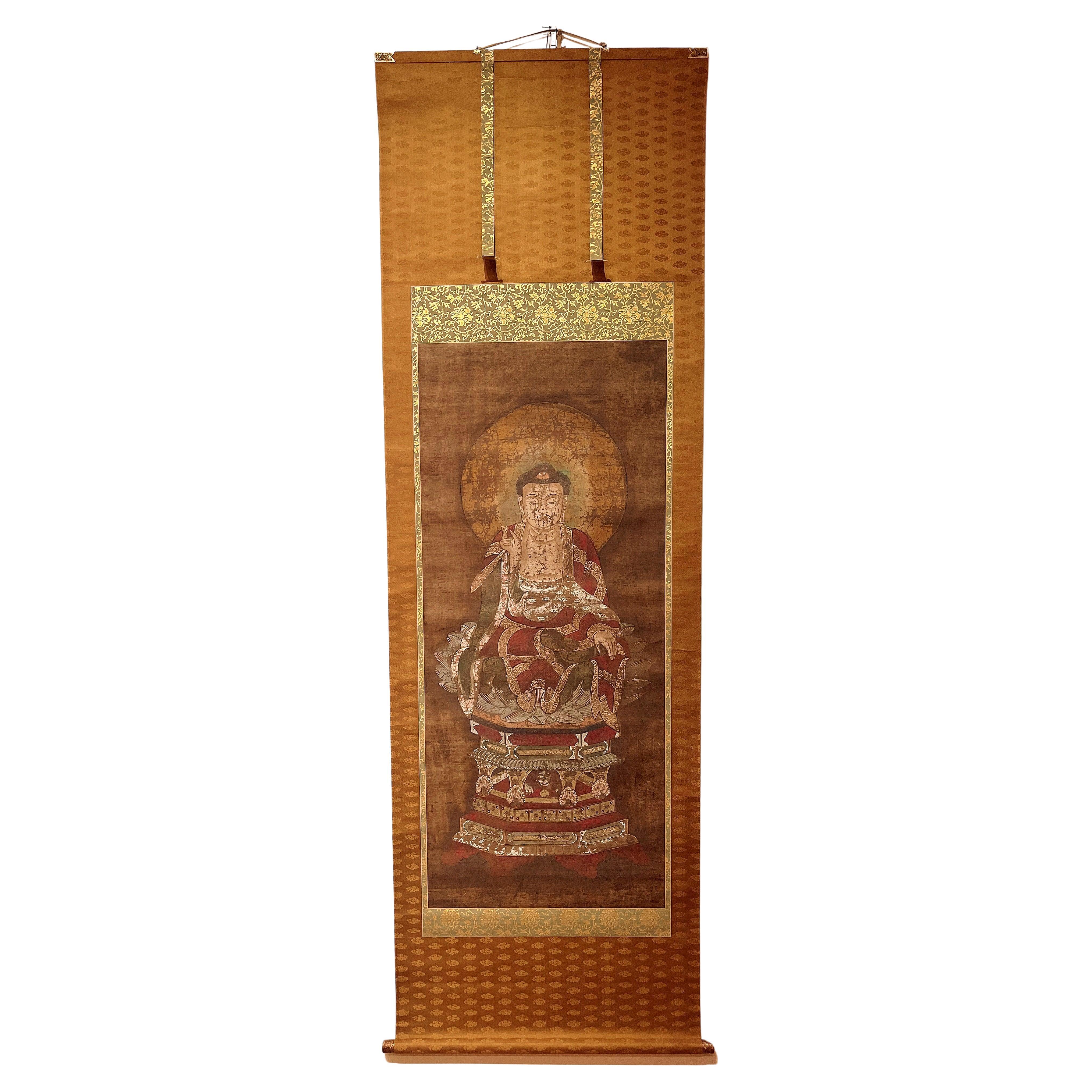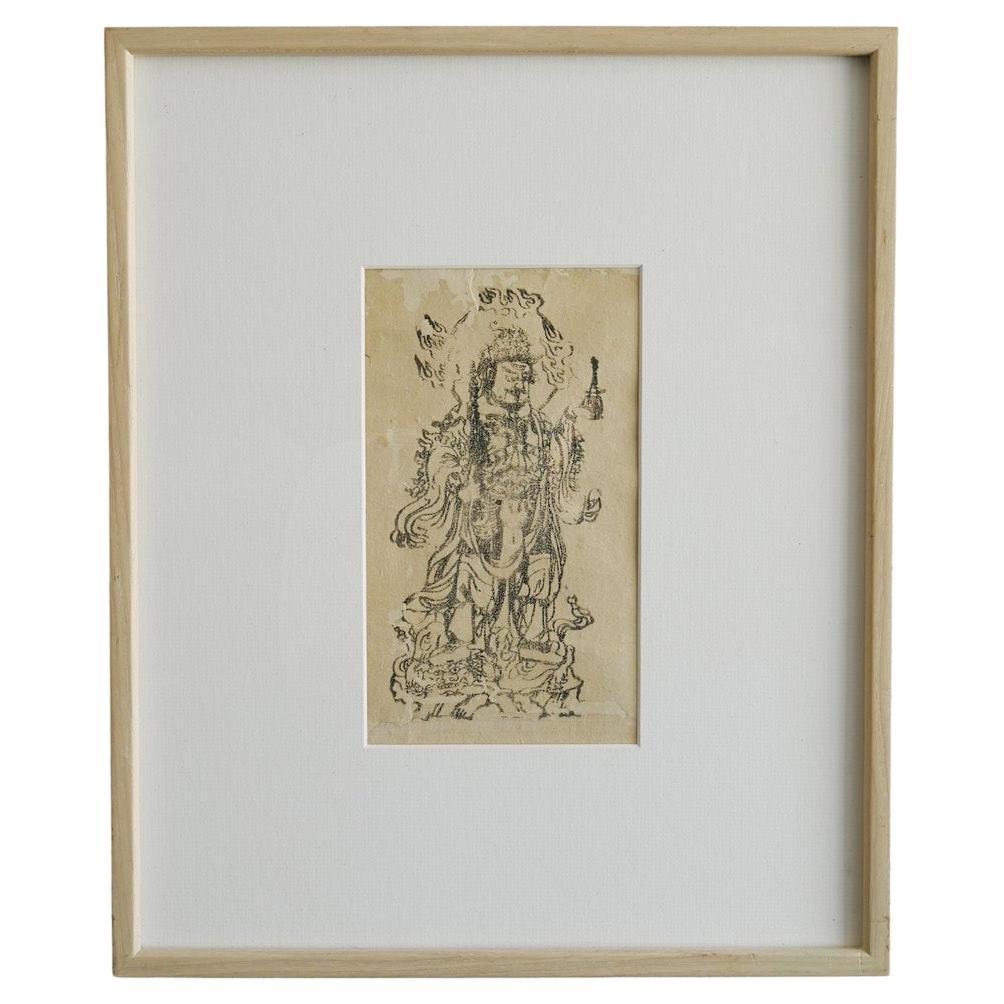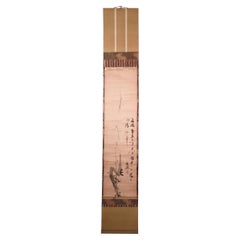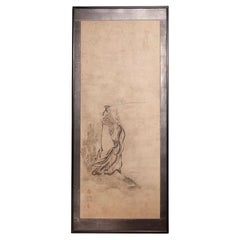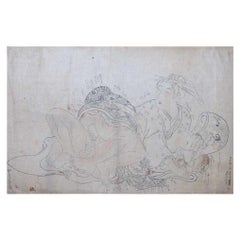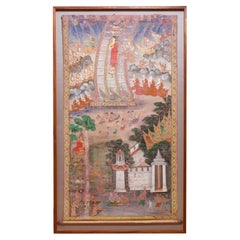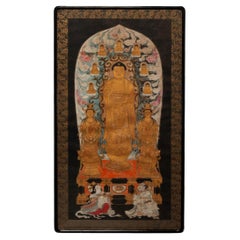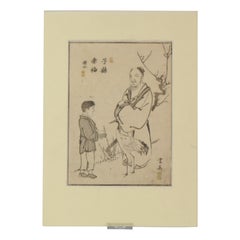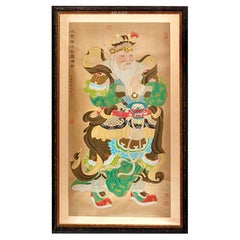Items Similar to Antique Chinese Printed Ink Rubbing of Panthaka Arhat, (scroll mounted)
Want more images or videos?
Request additional images or videos from the seller
1 of 15
Antique Chinese Printed Ink Rubbing of Panthaka Arhat, (scroll mounted)
$800
£604.65
€696.88
CA$1,128.80
A$1,244.02
CHF 651.28
MX$15,280.45
NOK 8,183.52
SEK 7,659.13
DKK 5,203.17
About the Item
Chinese ink rubbing printing depicting Panthaka Arhat, no.4 of the 16 arhat images immortalized in stone at the former stupa at Shengyin Temple. Depicted here sitting on a rock with a book in his left hand and snapping his fingers in his right hand, symbolic of the speed at which he obtained enlightenment, accompanied by a beggar’s bowl and an incense burner, complete with colophons and silk scroll mounting. The Emperor Qianlong ordered the stone stele to be carved in 1764 after the arhat designs painted by the famed artist Guanxiu (832-912). Even though the temple was destroyed in the Taiping rebellion, the steles remain and have been reinstalled at the Hangzhou Stele Forest. Condition: Creases from rolling, otherwise fine condition. Mounting: 58” x 22”. 19th Century. Ex Collection: Frank “Till” & Peggy Durdin, San Diego.
For other rubbings of this stele see:
Penn Museum, object number 2010-26-4
The Metropolitan Museum of Art AN#: 59.195.15
Fine Arts Library of Harvard University, record id: W280021_urn-3:FHCL:478850
For another example of this image rendered in jade and lacquer see: “Screen Paintings of Guanxiu’s Sixteen Arhats in the Collection of the Palace Museum” Luo Wehhua translated by Bruce Doar, Orientations, September 2010, p. 104. In this article the image is identified as the sixteenth arhat Abheda, It is explained in this article that Qianlong re-identified the arhats, thus the 16th Arhat attribution for this image. Also in this article the identical colophon by Qianlong above the image is translated as: “These accurate portraits of the Sixteen Arhats were created by the Tang Dynasty painter Guanxiu, as recorded in Xuanhe Huapu (Record of paintings in the Xuanhe Reign), and during the millennium from the Guangming reign period to the present day, the original works were to be found in Zhejiang, where they were housed in the collection of Shengyin Temple in Qiantang (Huangzhou). In spring of the dingchou year (1757) of his reign, the Qianlong emperor undertook a southern tour of inspection and stayed at an imperial lodge on the West Lake. He went to the temple to pay his respects and there he saw the arhats on display and wrote a description of these marvels. The sequence of the arhats and their names had been passed down since ancient times, but they did not correspond to their Sanskrit titles; the sequence of the arhat names conformed instead to the interpretation of the Sanskrit classics by the Zhangjia State Preceptor. The emperor penned the original names and positions in the sequence below each of the figures in accordance with the readings supplied in Tongwen Yuntong (Unified Rhymes), and below each he penned an encomium, which he signed. Then the images were returned to the collection, to be passed down as a perpetual treasure. Now, the fourth great arhat had long gone missing and we did not know where his painting was. But it was merely a trifling matter of matching the images with the names, and now surely we have found him! This I, the emperor, believe.”
All 16 of these rubbings can be found in the Rubel Chinese Rubbings Collection at the Fine Arts Library of Harvard University with the following descriptive historical note: “Rubbing from stele depicting No. 4 of 16 arhats (Lohans, Buddhist saints) -- Nan ti mi duo luo qing you, Panthaka Arhat. Original painting attributed to Guanxiu, 832-912. Inscriptions written by Hongli, Emperor Qianlong (Gaozong, 1711-1799) of Qing Dynasty. 7 seals of Qianlong follow the inscriptions. Script style: in xing shu. Shi liu zun zhe -- "The 16 noble ones" are 16 lohans. Lohans are also called "a-lo-han" based on the transliteration of the Sanskrit term "arhat." (Japanese: Rakan; Chinese: Lohan; Tibetan: Gnas-brtan). Arhats or Arahants are saints or sages said to have renounced nirvana (freedom from the cycle of suffering and rebirth), vowed to remain in the world to protect the Dharma and propagate the Law of the Buddha in order to devote themselves more effectively to the relief of human misery, like the Bodhisattvas. These 16 Arhats, personal disciples distinguished by the Buddha, formed part of the 500 claimed by tradition to have attended the First Council in Rajagrha. The names and abodes of these 16 arhats are given in a work entitled "Record on the Duration of the Law, spoken by the Great arhat Nadimitra," which was translated into Chinese by the famous pilgrim Xuanzang (596-664) in 654. 16 lohans are quite often represented, especially in China and Japan, in sculpture and painting, in poses and with attributes. Every lohan can be easily with special icongraphic characteristics. Guanxiu (Jiang Deyin or Deyuan, a Buddhist monk also named Master Chan Yue, 832-912) -- painter during late Tang to Five Dynasties, specialized in painting lohan figures. Legend has it that the first portraits of the 18 Lohans were painted by Guan Xiu, in 891 A.D. According to records, it was because of his expert painting skill that the Lohans chose him to paint their portraits. They appeared to him in his dreams to make that request. Guan Xiu often said, "It was in a dream that I saw these Gods and Buddhas. After I woke up, I painted what I saw in the dream. So, I guess I can refer to these Arhats as 'Arhats in a dream.'" Guanxiu depicted lohans in the form of "those beyond this world"-- strangely eccentric. All 16 lohans have bushy eyebrows, large eyes, protruding cheekbones, a long nose, and an Indian or Central Asian countenance; thus it appears very different from that of native Chinese monks. Sheng yin si shi liu zun zhe xiang -- Guanxiu's Portraits of sixteen arhats in Shengyin Temple. It is recorded Guanxiu's 16 Lohans were given to a Buddhist monastery near Qiantang (currently Hangzhou) in the province of Zhejiang. These became famous and were preserved with great care and ceremonious respect. In the reign of Qianlong, Qing Dyansty (c. 1750) an official had copies made by competent artists and sent them to the emperor who had further copies made, printed and distributed. When it was found that names were incorrectly assigned, the emperor took care to see that the copies be compared with the originals and correctly transcribed. Sheng Yin Temple-- located near current Gushan (Solitary Hill) in Hangzhou, Zhejiang ; the temple was destroyed during 1850-1864 by an opposition group called "Tai ping tian guo" ("Heavenly Kingdom of Peace"). Stele date: 8th. mo. of 29th yr. of Qianlong, Qing dynasty (1764).”
Also The Metropolitan Museum of Art, New York AN#:59.195.15 with the following description: 清 臨貫休十六羅漢圖 (拓片) Luohan, after a set attributed to Guanxiu,stone carved in 1757; rubbing 18th or 19th century?. Of the many luohan painters throughout Chinese history, none was more influential than the Buddhist monk Guanxiu (832–912), whose wild caricatures inspired generations of artists to depict luohans as exotic, superhuman beings. Guanxiu’s paintings were already considered rare in 1757, when the Qianlong emperor encountered what he believed to be an authentic set in a monastery in Hangzhou. To preserve their appearance, the emperor commissioned copies and had them carved in stone so that rubbings like these could be made. The original paintings are now lost, making these copies some of the most important surviving evidence of Guanxiu’s style.
For more information on the carvings of Shengyin temple see Apollo Magazine, November 2003.
- Dimensions:Height: 58 in (147.32 cm)Width: 22 in (55.88 cm)Depth: 1 in (2.54 cm)
- Style:Qing (Of the Period)
- Materials and Techniques:Paper,Other
- Place of Origin:
- Period:
- Date of Manufacture:19th Century
- Condition:Wear consistent with age and use. Creases from rolling, otherwise fine condition.
- Seller Location:Point Richmond, CA
- Reference Number:Seller: TM-UA060641stDibs: LU1778241857782
About the Seller
5.0
Platinum Seller
Premium sellers with a 4.7+ rating and 24-hour response times
Established in 1999
1stDibs seller since 2015
698 sales on 1stDibs
Typical response time: 2 hours
- ShippingRetrieving quote...Shipping from: Palm Springs, CA
- Return Policy
Authenticity Guarantee
In the unlikely event there’s an issue with an item’s authenticity, contact us within 1 year for a full refund. DetailsMoney-Back Guarantee
If your item is not as described, is damaged in transit, or does not arrive, contact us within 7 days for a full refund. Details24-Hour Cancellation
You have a 24-hour grace period in which to reconsider your purchase, with no questions asked.Vetted Professional Sellers
Our world-class sellers must adhere to strict standards for service and quality, maintaining the integrity of our listings.Price-Match Guarantee
If you find that a seller listed the same item for a lower price elsewhere, we’ll match it.Trusted Global Delivery
Our best-in-class carrier network provides specialized shipping options worldwide, including custom delivery.More From This Seller
View AllJapanese ink on paper painting of Plum Blossoms, Tani Buncho
Located in Point Richmond, CA
Japanese ink on paper painting of Plum Blossoms and Poem, scroll mounting, signature & single seal: Tani Buncho (1763 - 1840). A famous and prol...
Category
Antique 19th Century Japanese Meiji Paintings and Screens
Materials
Paper
Antique Japanese Suibokuga Sage by Kano Tokinobu, 17th century.
Located in Point Richmond, CA
Antique Japanese Suibokuga Sage Painting by Kano Tokinobu, 17th century. A sumi-e ink on paper painting illustrating an acolyte at a riverbank. The image of the standing Chinese figure with elongated earlobes (a symbol of enlightenment), hair tied back in a kerchief and long beard, holds a large fan in his left hand to his right shoulder. The long robes are windswept with water curls about the figures feet. The painting with 3 vermillion seals of the artist in the lower left corner. Japanese dry mount paper on a wood frame with thin brocade border silver leafed surround and lacquered wood outer frame.
Condition: Paper restoration on center, a quarter of an inch of the left edge of the painting is added, other minor signs of age, wear, stains and repairs overall fine condition.
Age: Painting Edo Period, circa 1670. Mounting circa 1985.
Image: 51-1/2 in. x 20-1/2 in. (131cm x 52cm)
Frame: 59-1/4 in. x 25-1/4 in. (150cm x 64cm)
Weight: 6lbs.
Provenance:
with Honeychurch Antiques...
Category
Antique 1670s Japanese Edo Paintings and Screens
Materials
Paper
Framed Japanese ink on paper artist's instruction for a Shunga print
Located in Point Richmond, CA
Japanese ink on paper wood block shunga artist’s color and pattern illustration with instructions for the woodblock carver and printer, depicting...
Category
Antique Late 19th Century Japanese Meiji Paintings and Screens
Materials
Paper
Antique Thai Buddhist Banner Painting
Located in Point Richmond, CA
Antique Thai Buddhist Banner Painting, multi-coloured tempera and gold leaf on cloth, depicting Buddha Descending From Tavatimsa Heaven. An illustration o...
Category
Antique 1850s Thai Other Paintings and Screens
Materials
Textile, Plexiglass
Antique Shakyamuni Buddha Thangka Tapestry, 1950s
Located in Point Richmond, CA
Rare antique Thangka tapestry from around 1950. Depicting Siddhartha Guatama in the Pureland when he became Buddha and his Dharma name became Shakyamu...
Category
Mid-20th Century Tibetan Tibetan Scholar's Objects
Materials
Canvas, Silk
Japanese Noh/Kabuki Shakkyo painting, Torii Kiyotada
Located in Point Richmond, CA
Japanese colors, gofun and metallics on silk painting of Noh/Kabuki Dancers, depicting two figures of actors dancing in the play Shakkyo portraying a pair of shishi (lions), one on a...
Category
Early 20th Century Japanese Meiji Paintings and Screens
Materials
Silk
You May Also Like
Antique Japanese Buddhist Ink & Color On Silk Painting Amida Triad Buddha
Located in Forney, TX
A beautiful framed antique Japanese School ink and color painting on silk, 19th century, finely detailed and richly colored, depicting Amida Triad, with two Bodhisattva attendants worshipping Buddha, on a gilt arabesque mat, in a black frame.
Provenance / Acquisition:
A Private Dallas Collector
Acquired from the highly reputable auction house Dallas Auction Gallery, Dallas, Texas. Summer Fine Arts and Antiques catalog.
Owned and curated by Reyne Hirsch, a notable media personality and expert in 20th century decorative arts. She's was a top appraiser for Antiques Roadshow...
Category
Antique 19th Century Japanese Edo Paintings and Screens
Materials
Metallic Thread
Very Fine Chinese Woodblock Print China Antique, 19th Century
Located in Amsterdam, Noord Holland
Interesting and finely made print
Interesting and finely painted Chinese Silk painting.
Additional information:
Material: Porcelain & Pottery
Type: Paintings, Scrolls & Prints
Regio...
Category
Antique 19th Century Chinese Prints
Materials
Porcelain
$255 Sale Price
20% Off
A Chinese Framed Scroll Of An Elder Man
Located in Bradenton, FL
Antique framed Chinese scroll of an elder Chinese man. Scroll features a bearded Chinese man wearing traditional colorful and ornate clothing. Vibrant colors of teal, red, gold and b...
Category
Antique 19th Century Chinese Chinese Export Paintings and Screens
Materials
Paper
Chinese Mythical Immortal Screen Painting, c. 1850
Located in Chicago, IL
Since the 12th century, people in China have used folding screens and doors to partition and decorate their homes - the vivid scenes backing the screens added life and color to a roo...
Category
Antique Mid-19th Century Chinese Paintings
Materials
Fabric, Paint
Japanese Buddhist Painting of Sitting on Lotus Crown, Scroll Painting
Located in Greenwich, CT
Japanese Buddhist Painting Sitting on Lotus Crown Seat
Ink and color on silk
Overall size : 25.6" width 81" height
Image size: 19.7" widt...
Category
Antique 19th Century Japanese Paintings and Screens
Materials
Silk
$2,500 Sale Price
34% Off
A frame with an old Japanese Buddhist woodblock print / amulet / 1800-1912
Located in Sammu-shi, Chiba
This is a woodblock print made between the late Edo and Meiji periods (1800-1912).
It was originally a talisman given to visitors to temples as a good luck charm.
It is unclear which...
Category
Antique Late 19th Century Japanese Edo Prints
Materials
Paper
More Ways To Browse
Ink Scroll
Antique Chinese Prints
Legend Of Asia
Asian Art Scrolls
Chinese Late 19th Century Bowl
Japanese Temple Sculpture
Japanese Stone Carving
Large Jade Carving
Chinese Temple Carvings
Large Chinese Urn
Large Stone Urn
Indian Temple Carving
The Imperial Palace Of China
18th Century Pen And Ink
Qianlong Emperor
19th Century Chinese Painting On Silk
Japanese Painted Silk Scroll
Chinese Emperor Painting
